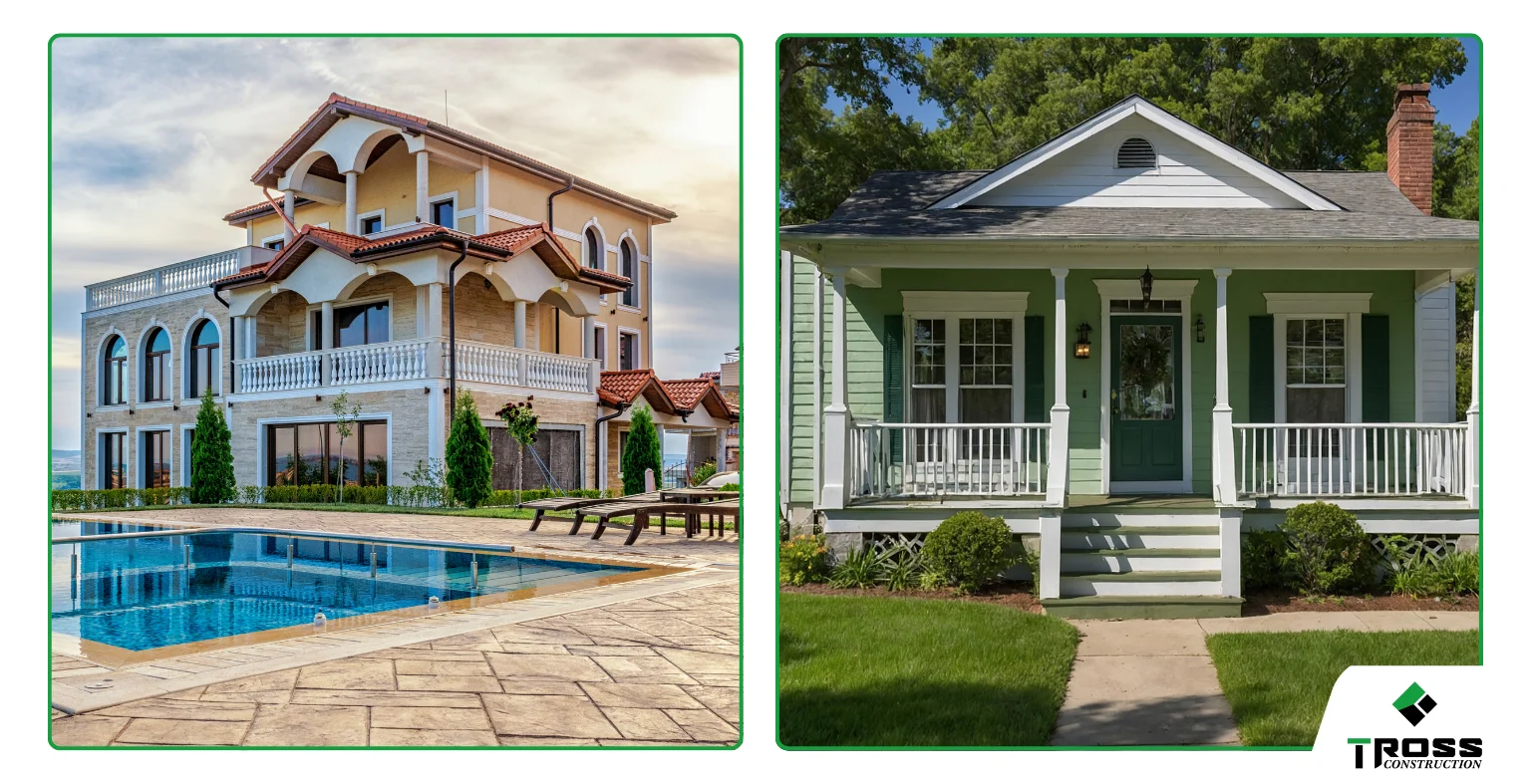Do you feel that your home is full to overflowing? Maybe the kids aren’t so little anymore, your hobbies require more room or you are finally prepared to build that dream kitchen or cozy family dinner area.
Whatever’s pushing your walls out, expanding your home can be one of the wisest investments because it enhances your daily comfort and your property’s value.
But before the preliminary drawings come out, there is one big question that requires an answer: What’s it really going to cost to add more space?
Understanding home extension costs in Canada can be tricky. Costs can fluctuate significantly based on location, size, and materials.
In this guide, we will tell you everything you need to know about the home extension cost per square foot and how to use a home extension cost calculator. Wait Wait Wait! There is something more! We will also tell you some insider tips to plan your project without breaking the bank in 2025.
Read till the end and thank us later!
What Is the Typical Home Extension Cost in Canada?
To get a grip on how much you’ll require to budget, let’s begin with some basic numbers. The average home extension in Canada generally costs between $100,000 and $300,000 — a significant range, but there’s good reason for that.
The cost depends to large extent on:
- The size of your extension
- Whether you’re adding a new floor, building laterally (outwards), or finishing your basement
- The materials and finishes you choose
- The type of the design and construction
Look at the table showing average home extension cost per square foot to give you a clearer picture:
| Type of Extension | Average Cost per Square Foot (CAD) |
| Adding a new floor (second storey) | $175 – $400 |
| Single-storey lateral extension | $200 – $500 |
| Basement finishing | $70 – $100 |
| Two-storey addition (ground floor) | $360 – $480 |
| Two-storey addition (second floor) | $210 – $240 |
These figures are for core construction, but take into account: costs can increase with high-end finishes or additional site preparation.
Why Does Size Matter So Much?

It’s no exception that bigger projects cost more. But here’s an insider tip: as your home extension gets larger, the cost per square foot often decreases. This is called economies of scale.
Why? Because fixed costs like an architectural fees, permits, and mobilization of workers get spread over a larger area. Moreover, buying materials in large amount over and over reduces costs. So, a a 500 sq.ft. extension might cost you $400 per square foot, but a 1,500 sq.ft. extension could come in closer to $300 per square foot.
Still, total spending will increase with size, so balance your requirement for space with your budget mindfully.
Key Factors That Drive Home Extension Costs
1. Materials and Finishes
One of the biggest pocker-drainers is the choice of materials. Do you need:
- Natural stone or brick siding? Anticipate to pay more for the premium look and durability.
- Vinyl or fiber cement siding? These are budget-friendly yet durable alternatives.
- High-end hardwood flooring or standard laminate?
- Luxury fixtures and custom cabinetry or stock options?
Each of these options can add or reduce thousands of dollars to your final bill. If your objective is a more affordable extension, then it is required to search for quality materials that offer good longevity without the high price tag.
2. Complexity and Architectural Design
A simple rectangular extension with a flat roof is costs less to build than a large multi-level addition with vaulted ceilings, custom windows or unusual changes. Architectural features demands extra labor and materials.
Planning a home extension with a skilled architect upfront can help you achieve your dream while managing costs. Sometimes small changes in design can save big bucks.
3. Site Conditions and Location
Building on flat and stable land is easier and less expensive than working on rocky soie and steep slopes or you can think urban settings with limited space for equipment.
If your property requires demolition or foundation reinforcement, then expect extra fees. Likewise, local permit costs and construction regulations vary across Canadian provinces, so check with your municipality.
4. Labor and Contractor Quality
Hiring a reliable and insured contractor might cost more upfront but saves money on mistakes and delays. Be wary of rock-bottom bids because they can give rise to shoddy work or even legal headaches. Always ask for references, check insurance, and clarify contract details.
How to Use a Home Extension Cost Calculator
Budgeting for a home extension has never been easier! Luckily there are different online tools and government resources. These tools help you estimate cost by allowing you to input key variables such as:
- Extension size (in square feet)
- Type of addition (basement, single-storey, second storey)
- Location
- Material preferences
While there are many private calculators available, it’s time and again beneficial to consult government-supported resources for reliable guidance and up-to-the-minute information.
What Are Hidden Costs and Additional Fees to Watch For?

Many homeowners are surprised to find that the true cost of an addition goes well beyond just the construction itself. Hidden or unexpected expenses often include:
| Cost Type | What It Means |
| Building permits & inspections | You must get permission from your city to build. This cost changes by location. |
| Architect & engineer fees | You pay experts to plan your project. This usually costs 5% to 15% of the total. |
| Demolition or site prep | You may need to tear down old parts or clean the area before building. |
| Utility upgrades | You might need to add or move pipes, wires, or heating systems. |
| Landscaping | Fixing your yard or garden after building may cost extra. |
| Contingency fund | Always save 10% to 15% extra in case something unexpected happens. |
Planning for these upfront can help you avoid financial surprises and stress.
Financing Your Home Extension in Canada
Determining how to pay for a home extension is just as essential as designing it. Luckily, Canadian homeowners have several ways to finance their renovation projects. Here are some of the most popular options:
1. Home Equity Loans or Lines of Credit (HELOCs)
If your home’s value is gone up then you can borrow money based on that value to help pay for your extension. This type of loan generally has lower interest rates as compare to regular loans and you know what? sometimes the interest you pay can even lower your taxes. Just be sure to compare options and completely understand the repayment terms before you make any decision.
2. Personal Savings or Loans
Making use of your own savings can be a wise move if you want to stay away from debt — but only if it doesn’t leave your emergency fund empty. If savings aren’t enough, then personal loans are another choice. Although, they generally come with higher interest rates than equity-based borrowing.
3. Government Grants and Rebates
Depending on your region, you may be eligible for government support programs. These over and over apply to energy-sufficient upgrades (like insulation or windows) or accessibility renovations. Go to the Canada Mortgage and Housing Corporation (CMHC) website for up-to-date information on available grants and financing options customized to homeowners.
Smart Tips to Keep Your Home Extension Budget on Track
Managing your budget during a home extension can feel difficult, but a few smart moves can make a big difference. Let’s understand how to stay on top of your spending and avoid surprises:
- Get a different quotes before choosing a contractor. Don’t go with the first price you hear. Consult with at least three reputable contractors and ask detailed questions about what’s included together with comparing their estimates.
- Stay to the important parts first. It’s normal to get excited about fancy finishes or additional features but focus on what you truly require. You can always upgrade later if your budget allows.
- Stay involved in the process. Don’t leave everything on the contractor. Go over timelines and progress so you are not hit with unexpected expenses down the road.
- Always ensure you have a backup fund. No matter how well you plan, surprises always take place like:
- Hidden water damage
- Permit delays
- Rising material costs
Set aside at least 10-15% of your total budget for the unanticipated.
Final Words
Adding more space to your home is not a small decision. It’s a big investment! But it’s one that is really worthwhile by giving you more comfort and increasing your home’s value.
When you will carefully look at the all the factors and use helpful tools like a home extension cost calculator you’ll be better prepared to plan your project the right direction with fewer surprises along the way. Collaborating with a reliable company like Tross Construction signifies you’ll get expert guidance and top-quality work from start to finish. Your home extension will be done as you expected. On Budget. One Time. No guesswork, No stress!

